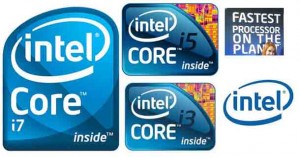
Cutting-edge processor performance is the trend of today’s computing. Users want laptops that run at a dizzying pace to get the job done fast and glitch-free. And there are gamers who require powerful PCs to run even sophisticated games, with ease. Yet, more users engage in multi-tasking work, where several applications are run at the same time. That requires solid performance from the PC. The result is that processor manufacturers have continued to up their game, releasing ever more powerful processors each time. The core of a PC’s performance lies in its processor. Intel has been at the fore of the effort to develop more powerful, faster and more efficient processors. Like its 2010 release – the Intel Core i-Series Processors. The Core i processors have been credited with advanced processor technology and faster performance. That processor family consists of the Core i3, Core i5 and Core i7 processors. Briefly. lets see what these processors offer: Core i3 ProcessorThe Core i3 is the entry range of the Core i-series Intel processors. Core i3 has Core i3-330M and Core i3-350M options as standard processors for laptops. It has also added the i3-330UM as a ULV (ultra-low voltage) processor for laptops. Similarly Core i3 offers Core i3-530 and Core i3-540 options for desktops. Basically, Core i3 processors are dual core processor (2 cores) and support four threads. In terms of clock speed, the offer 2.26GHz for i3-350M, 2.13GHz for i3-330M and 1.2GHz for the ULV i3-330UM, for the laptop processors. Core i3 processors are based on the same Nehalem architecture as other Core i processors, a new more efficient processor architecture developed by Intel. At the Core i3 level, which is the low-end of the Core i-series, some of Intel’s latest processor performance technologies are disabled. For instance, Intel® Turbo Boost Technology that delivers extra performance and increased energy efficiency is not offered by Core i3. Notwithstanding this, Core i3 is still powerful and comes with Intel® Hyper-Threading Technology, a major performance technology for more efficient use of processor resources. It also features Intel® Smart Cache (3MB), another performance technology that boosts data access during processing. With its 32nm Silicon Technology, the processor transistors are packed more densely than for earlier processors of wider transistors, resulting in less energy leak, less heat and faster switching. The Core i3 also comes with built-in graphics processing unit (GPU), Intel® HD Graphics. That ensures superb visual performance for sharper images, richer color, and life-like audio and video The bottom line: Core i3 is not just billed as a replacement for Core 2 Duo, it delivers better, faster performance, especially in multi-tasking. Both are 2 cores, but Core i3 is 4 threads, while Core 2 Duo is 2 threads. The Smart Cache of 3MB, over 2MB cache in Core 2 Duo is further advantage. Also the 32nm silicon technology of Core i3, compared to 45nm/65nm in Core 2 duo, delivers better result in power consumption and heat generation. Overall, you’re better off with Core i3 than Core 2 Duo. Knowing that Core 2 Duo dominated the processor space for some three years before now, you may now appreciate the high rating of the Core i3 processor, with its better technology and superior performance. Core i5 ProcessorsCore i5 also has standard voltage options for laptops, ultra-low voltage options for laptops and desktop options. Standard voltage laptop Core i5 processors are the Core i5-430M (2.26GHz), Core i5-520M (2.40GHz) and Core i5-540M (2.53GHz). The ULV options are Core i5-430UM (1.20GHz), Core i5-520UM (1.06GHz) and Core i5-540UM (1.20GHz). All Core i5 laptop options offer 2 cores and 4 threads, just like the Core i3 options. They also come with Smart Cache of 3MB, like Core i3. Their silicon technology is similarly 32nm, just as Intel® Hyper-Threading Technology is common to Core i5 and core i3. They also have built-in graphics processing unit (GPU), Intel® HD Graphics. However, apart from the higher clock speed in most Core i5 over Core i3, Core i5 processors have Intel® Turbo Boost Technology, a major performance boost. The Core i5 processors are actually the mid-range Core i processors, delivering more processing power and efficiency than the Core i3 options, but also with a higher price tag. The entry level Core i3 offers enough power for what most users do, but those who need more power and can afford it, a Core i5 offers more. For gamers, entertainment enthusiasts, video editors and the like, Core i5 will deliver better results. Core i7 ProcessorsWith the Core i7, expect the ultimate smart performance for your PC. The Core i7 delivers top performance, even for multitasking, gaming or multimedia applications. This is today’s high-end processor, boasting 4 cores and 8 threads for laptops and desktops. The i7-980x for desktops actually has 6-cores and 12-threads. Core i7 features powerful new processor technologies that deliver the smart processing performance it offers. These include:
No related posts. |
Recently Popular
|
Intel Core i-Series Processors – Core i3, Core i5 and Core i7 – what they Offer
 June 26th, 2010
June 26th, 2010  NewVista
NewVista |
|
 RSS Feed
RSS Feed Twitter
Twitter

 Posted in
Posted in  Tags:
Tags: 









